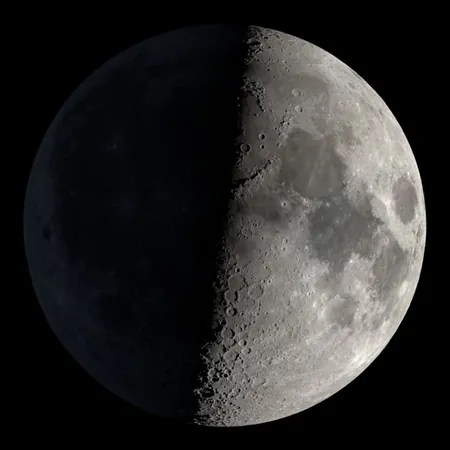
Discover the Celestial Wonders: Your Guide to the Night Sky from October 4 to 11!
2024-10-04
Author: Ming
Discover the Celestial Wonders: Your Guide to the Night Sky from October 4 to 11!
As October rolls in, it’s time to gaze up at the night sky and discover some awe-inspiring celestial events! From the majestic First Quarter Moon to the remarkable appearance of a comet, this week promises unforgettable stargazing experiences.
Friday, October 4: A Tale of Constellations
With autumn upon us, the winter constellations are beginning to rise earlier. Taurus stands out in the eastern sky, featuring the brilliant red giant star Aldebaran. Keep an eye on Jupiter, which is located near the Bull's horns, appearing brighter than Aldebaran. Don't miss the chance to locate NGC 1555, known as Hind's Variable Nebula, close to the variable star T Tauri. Best observed with a telescope, this cosmic cloud reveals its beauty under dark, moonless skies.
- Sunrise: 7:00 A.M. - Sunset: 6:36 P.M. - Moon Phase: Waxing crescent (3%)
Saturday, October 5: A Dance of the Moon and Venus
Tonight, the crescent Moon will glide just south of Venus at 4 P.M. EDT. After sunset, they’ll be an enchanting sight close together in the twilight. Observing Venus through a telescope during this time can uncover its stunning phases, while earthshine illuminating the Moon will add a breathtaking touch to your view.
- Sunrise: 7:01 A.M. - Sunset: 6:35 P.M. - Moon Phase: Waxing crescent (8%)
Sunday, October 6: Comet C/2023 A3 Returns
Be on the lookout for Comet C/2023 A3 (Tsuchinshan-ATLAS), which is becoming increasingly visible each morning. Just before dawn, it will hover low in the eastern sky, making for a perfect opportunity to capture stunning photographs.
- Sunrise: 7:02 A.M. - Sunset: 6:33 P.M. - Moon Phase: Waxing crescent (13%)
Monday, October 7: Scorpion’s Glow
As the Moon passes near Antares, the heart of Scorpius, keep your telescope handy for a breathtaking view of these two celestial bodies after sunset. Antares, a red giant star, can often be mistaken for Mars due to its color.
- Sunrise: 7:03 A.M. - Sunset: 6:32 P.M. - Moon Phase: Waxing crescent (21%)
Tuesday, October 8: Encounter with an Asteroid
Get ready to find Asteroid 39 Laetitia, now in the constellation of Cetus. Just north of it is Diphda, the brightest star in its constellation, which generates bright X-rays due to mysterious magnetic activity. Make use of your binoculars or telescope to spot the moving Laetitia on clear nights!
- Sunrise: 7:04 A.M. - Sunset: 6:30 P.M. - Moon Phase: Waxing crescent (29%)
Wednesday, October 9: Jupiter Takes Center Stage
Jupiter will appear stationary, making it an exceptional evening for observations. Don’t miss its moons, notably Ganymede, as they dance around this massive planet. Go further east to explore the mesmerizing Crab Nebula, remnants of a supernova explosion observed in 1054.
- Sunrise: 7:05 A.M. - Sunset: 6:28 P.M. - Moon Phase: Waxing crescent (39%)
Thursday, October 10: First Quarter Moon Magic
Tonight witness the First Quarter Moon at 2:55 P.M. EDT, with a beautifully lit half visible to the naked eye. This is the perfect time to observe sharp lunar features with details that are easily discerned along the terminator line.
- Sunrise: 7:06 A.M. - Sunset: 6:27 P.M. - Moon Phase: Waxing crescent (49%)
Friday, October 11: Pluto and the Double Cluster
As Pluto stands stationary, shifting your gaze to the constellation Perseus reveals the spectacular Double Cluster. Rich with brilliant stars, these clusters are a quintessential sight through binoculars or telescopes.
- Sunrise: 7:07 A.M. - Sunset: 6:25 P.M. - Moon Phase: Waxing gibbous (60%)
Ready to Reach for the Stars?
This week features an exciting lineup in the cosmos, so grab your telescope or binoculars and immerse yourself in the beauty of the night sky. Whether you're a seasoned astronomer or a curious novice, there’s something illuminating waiting for everyone. Happy stargazing!



 Brasil (PT)
Brasil (PT)
 Canada (EN)
Canada (EN)
 Chile (ES)
Chile (ES)
 España (ES)
España (ES)
 France (FR)
France (FR)
 Hong Kong (EN)
Hong Kong (EN)
 Italia (IT)
Italia (IT)
 日本 (JA)
日本 (JA)
 Magyarország (HU)
Magyarország (HU)
 Norge (NO)
Norge (NO)
 Polska (PL)
Polska (PL)
 Schweiz (DE)
Schweiz (DE)
 Singapore (EN)
Singapore (EN)
 Sverige (SV)
Sverige (SV)
 Suomi (FI)
Suomi (FI)
 Türkiye (TR)
Türkiye (TR)